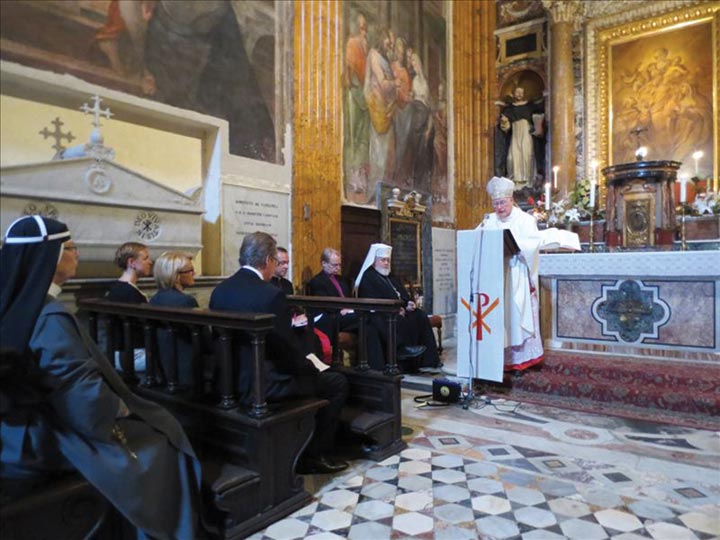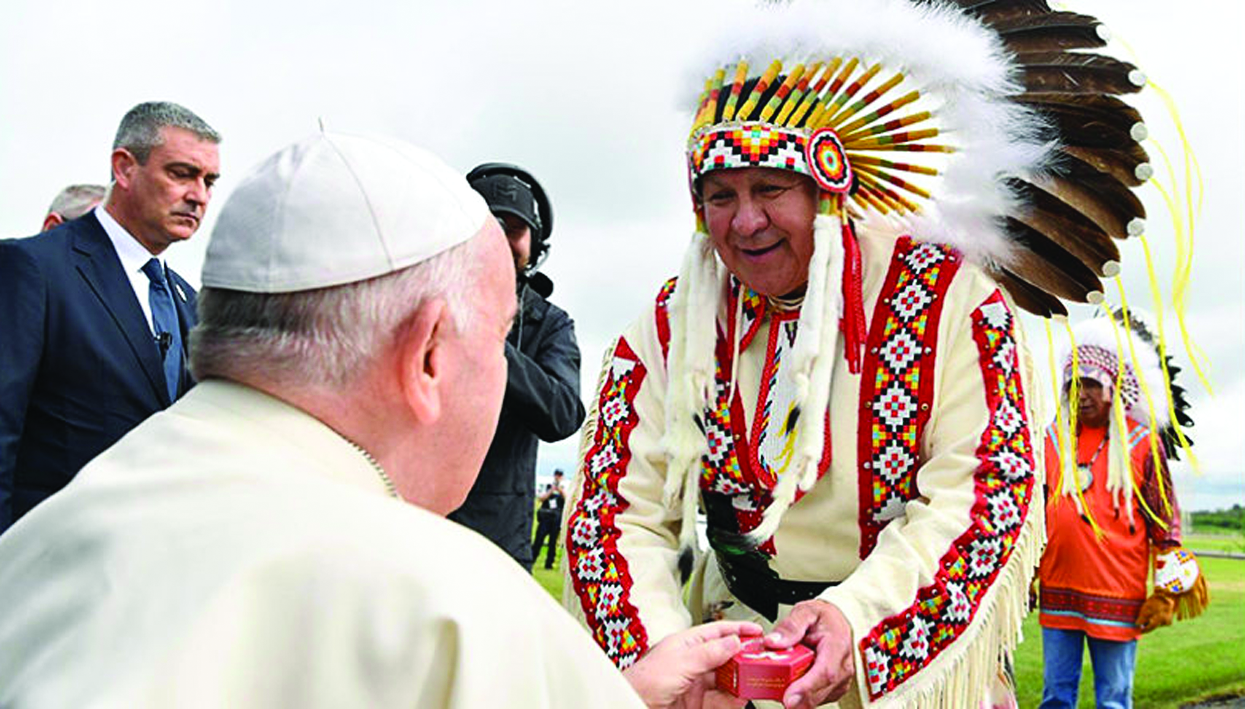In 1942, diplomatic relations between Finland and the Holy See were established, during the papacy of Pius XII, who supported Finland, attacked by Hitler’s Germany

A Catholic Mass in the early afternoon at the Finnish national chapel in the stately Basilica of Santa Maria Sopra Minerva
Perhaps it’s not a coincidence that the Holy See and Finland celebrated the 70th anniversary of their diplomatic relations on June 16, 2012, with a series of initiatives based on two highlights: a Catholic Mass in the early afternoon at the Finnish national chapel in the stately Basilica of Santa Maria Sopra Minerva, and a function at the Finnish embassy to the Holy See, the Renaissance Villa Lante al Gianicolo.
Besides being one of the feast days of St. Henrk, Finland’s patron saint after whom the above chapel is named, June 16 is also the eve of the annual national pilgrimage to the small island of Köyliö, where according to tradition, St. Henrk was martyred in 1156 while bringing the Gospel to the local pagans. This is a tradition that is still disputed today by some, to point that doubts are also cast on the saint’s very existence, although it would appear highly unlikely for Church-approved devotion to this saint to have taken root, consolidated and been perpetuated over centuries had it not been based on proven and acknowledged evidence.
“When we celebrate the Eucharist we can remember Jesus’ words that are repeated in every Mass: I leave you peace, I give you my peace,” the Catholic bishop of Helsinki, Msgr. Teemu Sippo, said in his homily as main celebrant of the Mass at the national Finnish chapel. “These words are at the same time a wish and a task.”
A task that the Holy See and Finland have tried to accomplish to the best of their abilities. Because especially today, he pointed out, “peace and the peaceful coexistence of peoples are no foregone conclusion, as we learn every day in the media. We must all strive for peace also within our realm of life, always defending what is true and good, what edifies our society, what can advance justice. I am convinced that the teaching of the Pope in union with the Church can greatly support and edify us in this.”
In the Service of Peace
The Holy See and Finland are both, each according to their specific spheres of competence, in the service of peace, he recalled.
“In the international community, on many issues, if not all, we pursue the same objectives, in particular in the field of peace, solidarity and development promotion,” he said. “These issues are dealt with in the social doctrine of the Catholic Church, which is of great interest to both the European Union and to Finland.”

Villa Lante al Gianicolo: (from l. to r.): Msgr. Sippo, Prof. Salonen, Archbishop Mäkinen, Archbishop Mamberti, Minister Räsänen, Ambassador Rusi and Archbishop Leo of Karelia and All Finland
Moreover, he went on, “the relationship of our particular Church with the Holy See bears significance also for the other churches and denominations of our country.”
In particular, “in this regard I would like to express my joy at the fact that at the Mass today are in attendance not only high-ranking representatives of Finland and the Holy See, but also the archbishops of the Lutheran and Orthodox Churches.”
A follow-up to the anniversary celebration was a symposium with various speakers, who took stock of the excellent relations between the two states from their respective spheres of interest and competence. Subsequently, a reception with drinks and refreshments wound up the celebration.
After the introductory remarks of the ambassador to the Holy See, Alpo Rusi, who recalled that in February 1918 Pope Benedict XV was among the first to recognize Finland as an independent nation, the floor was taken by Msgr. Dominique Mamberti, secretary for relations of states with the Holy See, who praised the work done and the results achieved in the frame of increasingly consolidated relations between Finland and the Holy See.
In particular, as reported in L’Osservatore Romano (June 19, 2012), he pointed out that the two states are on record in the defense and upholding of human rights.
Little did anyone know that Finland and in particular Helsinki, he went on, would become in Blessed John Paul II’s own words “almost synonymous with the conviction that respect for human rights constitutes the essential foundation of a world of peace and justice,” thanks to the providentially successful outcome of the 1975 Conference on Security and Cooperation in Europe, in which the Holy See played a prominent part.
Msgr. Mamberti went on amply quoting again from this pontiff’s statements during his visit to the country in June 1989. On that occasion, John Paul, who used to define himself as a most eminent “friend of Finland,” explained how “our good relations and our effective collaboration in the pursuit of an international order more solidly based upon justice, peace and an authentic development of peoples” were none other than a natural expression of the Holy See’s presence and activity in the international community.
On the other hand, the Pope acknowledged that Finland boasted an outlook and cultural identity “rooted in the lofty moral and social principles that are part of [her] most precious heritage” and the “recourse to methods of negotiation, of loyal discussion, of understanding [and] of tolerance” allowed her to play “a role in international relations which does her honor.”
Great Mutual Esteem
Hence the great esteem in which the Holy See holds its relationship with the Finnish nation, Msgr. Mamberti remarked, as also shown by other pontiffs.
For example, he recalled that the late Paul VI described as a “joyful surprise” the moment when the Holy See came to know that Finland was seeking to establish formal relations, the first among all the Northern European states to do so.

Finland’s gratitude to the Holy See was also underlined in a different wording in the press release circulated by the Finnish embassy for the occasion. At the outbreak of the Winter (Russian-Finnish) War in 1939, Pius XII reacted forcefully in support of “the small Nordic and Christian country against the brutal attack of a great atheist power,” condemning in his Christmas speech both Communist Russians and Hitler’s Germany, at the time an ally to the Soviet Union under the infamous “Ribentropp-Molotov” pact.
No Longer a “Foreign Element”
Besides the three religious leaders, other keynote speakers were the minister of the interior of Finland, Mrs. Päivi Räsänen, and Professor Kirsi Salonen of the University of Tampere, who spoke about the unfolding of Vatican-Finnish relations from the political and historical angles, respectively.
Official diplomatic relations were established a few years later, on July 31, 1942.
It is thanks to these relations that today, as aptly recalled by Archbishop Mäkinen in his address, the Catholic Church in Finland, from being previously perceived as a foreign element to be looked at with suspicion and wariness, has now come to be seen as a full-fledged component of the national religious mainstream. All the more so after it joined the Finnish Ecumenical Council in 1968 on a par with the other two Churches, so much so that it is by now regularly invited to the top official state events, such as the opening of Parliament and the official celebrations for the national Independence Day, December 6.
The presence of high-ranking representatives of the Holy See and notably from the secretariat of state, including its chief of protocol, Msgr. Fortunatus Nwachukwu, its assessor for general affairs, Msgr. Peter Brian Wells, and Nunciature Secretary Msgr. Tuomo Vimpari, goes a long way in showing the importance attached by the Pope to relations with the Nordic country.
Msgr. Vimpari is a native Finn, as is Msgr. Sippo, who is the first Finn to serve as a Catholic bishop after over 500 years since the Reformation and whose appointment on June 16, 2009, was hailed as a “historic move” by Finland’s major daily Helsingin Sanomat.
Sister Marja-Liisa Mäkiranta, a senior member of the Bridgettine Order, was also in attendance, another native Finn adding to the country’s budding native Catholic establishment.
Last but not least, emissaries of the Italian political establishment were present, including the founder of the Comunità di Sant’Egidio, Professor Andrea Riccardi, currently Italy’s minister for international cooperation and integration without portfolio in the Mario Monti-led technocrat Cabinet.






Facebook Comments